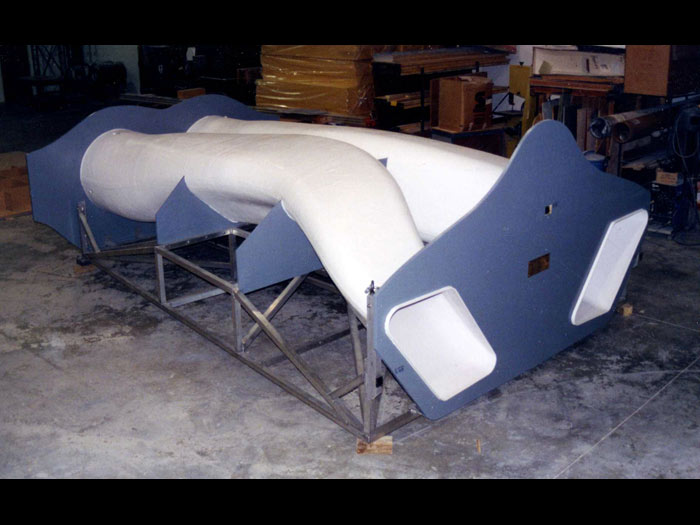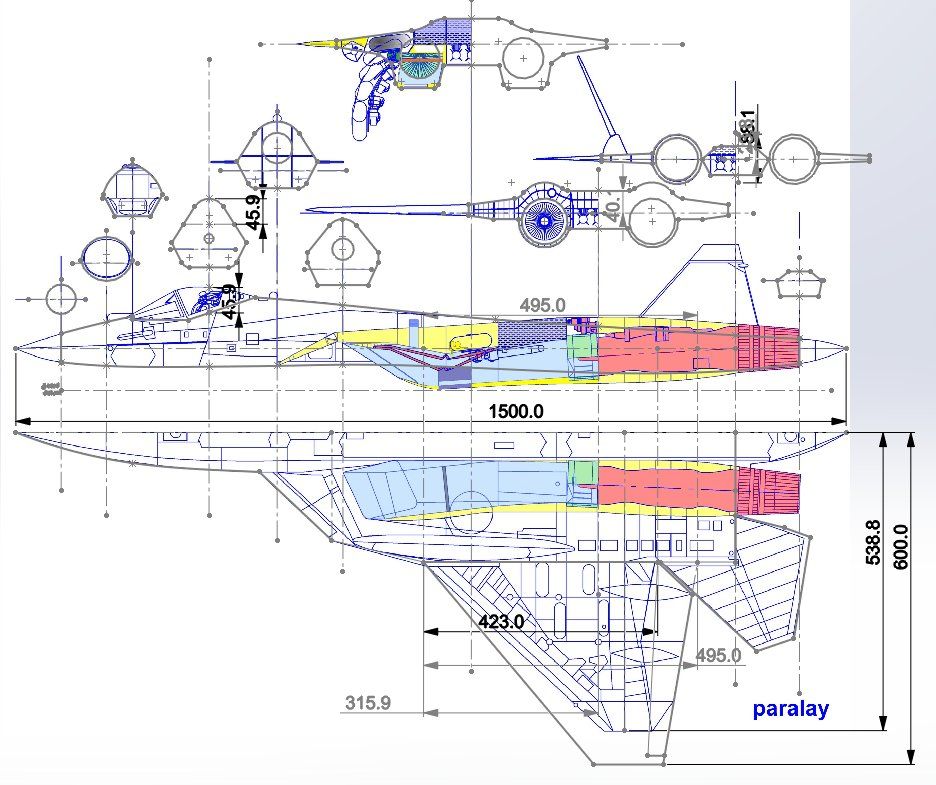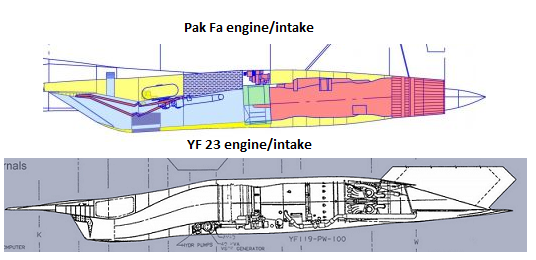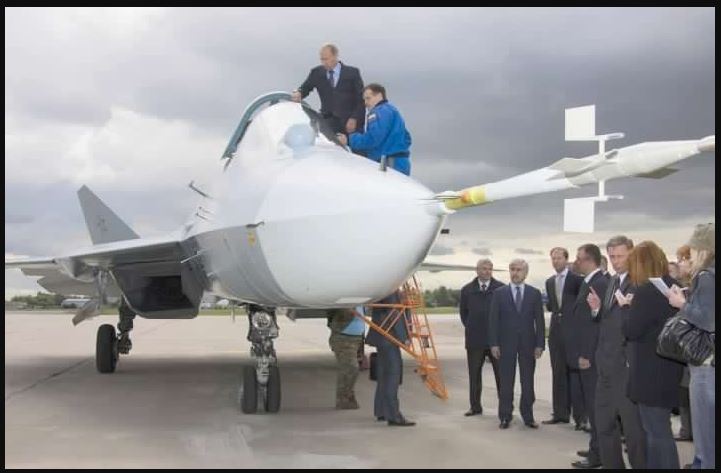It looks like you're using an Ad Blocker.
Please white-list or disable AboveTopSecret.com in your ad-blocking tool.
Thank you.
Some features of ATS will be disabled while you continue to use an ad-blocker.
share:
originally posted by: drwire
a reply to: zukli
F-22 midbody mockup
PAK-FA engine intake layout
DSI hides engine much better than S duct intake does. Not only that, DSI has no moving parts. It's much lighter than traditional intake and it requires no servicing. Russia don't have DSI technology. If Russia has DSI technology Russia use it on every new plane. The fact is Su-35 and Su-57 and MiG-35 don't have DSI proves Russia don't have DSI technology like China and America do. China and America puts DSI on every new plane.
edit on 28-12-2018 by zukli because: (no reason given)
originally posted by: Zaphod58
a reply to: zukli
And they get what they pay for. They still have big production issues on just about all their aircraft.
Correct. If I'm not mistaken, Russia spends more than 5% of GDP on defense. America only recently upped defense spending to 3% of GDP and that's because of Trump. Under Obama is was about 2% of GDP.
originally posted by: drwire
a reply to: RadioRobert
not hidding enough
Picture does not reflect actual geometry of the aircraft or duct. So you're either looking at a fake photo, inlet flow vanes/radar blocker, or all of the above.
Since the only photo that shows this is a picture apparently taken at night in weather no less, I'd be pretty shocked if this photo represents reality as opposed to being manipulated.
originally posted by: RadioRobert
originally posted by: drwire
a reply to: RadioRobert
not hidding enough
Picture does not reflect actual geometry of the aircraft or duct. So you're either looking at a fake photo, inlet flow vanes/radar blocker, or all of the above.
Since the only photo that shows this is a picture apparently taken at night in weather no less, I'd be pretty shocked if this photo represents reality as opposed to being manipulated.
According to schematics, less than half of engine shows.
upload.wikimedia.org...
edit on 28-12-2018 by zukli because: (no reason given)
originally posted by: RadioRobert
originally posted by: drwire
a reply to: RadioRobert
not hidding enough
Picture does not reflect actual geometry of the aircraft or duct. So you're either looking at a fake photo, inlet flow vanes/radar blocker, or all of the above.
Since the only photo that shows this is a picture apparently taken at night in weather no less, I'd be pretty shocked if this photo represents reality as opposed to being manipulated.
It might not be fake. Super Hornet also uses S duct and it also shows a lot of engine.
www.f-16.net...
originally posted by: RadioRobert
a reply to: zukli
DSI hides engine much better than S duct intake does.
That's pretty much a throwaway statement. It also shows you didn't look at the geometry of the F-22, F-23, or Su-57 that was presented in the post you were responding to.
The benefits of DSI goes beyond hiding engine. It is more aerodynamic than traditional intake. There is no splitter separating intake from the main fuselage. DSI is truly part of the fuselage. On top of being more aerodynamic, it is much lighter due to containing no ramps and moving parts, no need to service like traditional intake needs, and it looks better too.

I thought I would post an updated picture of the intake from that source I linked earlier.
The intake and first stage of the engine is highly shielded and uses RCS reducing electronics.
The moveable mesh keeps debris from entering the engine allowing for operation off rough runways. This mesh has a RCS reducing design supposedly.
The mesh is probably similar in design to the air outlets on the side.
edit on 12 28 2018 by tadaman because: (no reason given)
Anyway, the reflection of engine is exaggerated. There is no evidence engine has more radar signature than fuselage.
a reply to: zukli
DSI is simply a method of boundary layer control. It pushes most of the boundary layer up or down away from the inlet. The F-22 uses a splitterplate to eliminate the boundary layer. It has a fixed ramp, as well ( "no moving parts"). The Su-57 uses a splitter plate also. The F-23 used a different setup. A fixed inlet is optimized for a single mach speed and is less efficient in other parts of the envelope. The reason people use heavier, more complex ducts is for higher efficiencies across the envelope. As they have done for ages. People aren't dumb.
A DSI can "also" help block the compressor face -- in the same way a properly designed duct does.
There's no "secret DSI technology" that the Russians don't have. It's modelling and trial and error. They've either decided they prefer the benefits of efficient flow variably optimized for its current speed provided for by traditional inlets or they've opted not to design a DSI designed to the parameters of the interim engine.
DSI is simply a method of boundary layer control. It pushes most of the boundary layer up or down away from the inlet. The F-22 uses a splitterplate to eliminate the boundary layer. It has a fixed ramp, as well ( "no moving parts"). The Su-57 uses a splitter plate also. The F-23 used a different setup. A fixed inlet is optimized for a single mach speed and is less efficient in other parts of the envelope. The reason people use heavier, more complex ducts is for higher efficiencies across the envelope. As they have done for ages. People aren't dumb.
A DSI can "also" help block the compressor face -- in the same way a properly designed duct does.
There's no "secret DSI technology" that the Russians don't have. It's modelling and trial and error. They've either decided they prefer the benefits of efficient flow variably optimized for its current speed provided for by traditional inlets or they've opted not to design a DSI designed to the parameters of the interim engine.
originally posted by: RadioRobert
a reply to: zukli
DSI is simply a method of boundary layer control. It pushes most of the boundary layer up or down away from the inlet. The F-22 uses a splitterplate to eliminate the boundary layer. It has a fixed ramp, as well ( "no moving parts"). The Su-57 uses a splitter plate also. The F-23 used a different setup. A fixed inlet is optimized for a single mach speed and is less efficient in other parts of the envelope. The reason people use heavier, more complex ducts is for higher efficiencies across the envelope. As they have done for ages. People aren't dumb.
A DSI can "also" help block the compressor face -- in the same way a properly designed duct does.
There's no "secret DSI technology" that the Russians don't have. It's modelling and trial and error. They've either decided they prefer the benefits of efficient flow variably optimized for its current speed provided for by traditional inlets or they've opted not to design a DSI designed to the parameters of the interim engine.
LM has DSI technology because they developed it in the mid 1990s. Chinese have it because they stole it. Only LM and AVIC have DSI. No other company has DSI technology.
edit on 28-12-2018 by zukli because: (no reason given)
a reply to: RadioRobert
There was this to add with the image:
fullafterburner.weebly.com...
Edit to add:
There is also the possibility that the "N036L-1-01 L-band" arrays on the wing's leading edges use a similar method for EW jamming as the system masking the motors radar signature.
I bet there is a smaller more modular version of that system in the walls mitigating the motors RCS as part of their "smart skin" focus.
There was this to add with the image:
RCS Reduction in various sectors of the forward hemisphere is achieved by using S-shaped air intake duct and the coating of radar absorbing materials.
But if you look closely to those images available in the public domain, diagrams and photographs, it can be concluded that the inlet guide motor vehicle (GMV), or more simply - the first stage of the compressor to blades, it seems to be very clearly visible to enemy radar.
S-shaped channel provides only reduction of RCS in the axial directions to reduce the visibility of other sectors in the forward hemisphere, engineers in Sukhoi applied shielding to the GMV. (Something which people seem to be unaware about)
In the intake passage their is set special device, partially overlapping in the axial direction of the GMV preventing electromagnetic waves.
In addition to screening, this constructive solution separates inlet channel into several different cylindrical or planar voids, and, flat surface of the cavities can be both parallel and intersecting.
Such a complex segmentation and channel air intake cover wall segments with radar absorbing materials to reduce the power of the electromagnetic waves reflected from the GMV and from wall cavities, thus providing a decrease of the RCS in the forward hemisphere of the aircraft.
fullafterburner.weebly.com...
Edit to add:
There is also the possibility that the "N036L-1-01 L-band" arrays on the wing's leading edges use a similar method for EW jamming as the system masking the motors radar signature.
I bet there is a smaller more modular version of that system in the walls mitigating the motors RCS as part of their "smart skin" focus.
edit on 12 28 2018 by tadaman because: (no reason given)
a reply to: tadaman
Not really convinced that is the case because the geometry still looks wrong.
IF that quoted bit IS true, the guide vanes mentioned and visible are static and not moving. It's designed to impart direction to the flow before reaching the compressor stages for higher efficiencies. They aren't subject to a lot of heat and stress and are typically treated. It would also mean no radar blocker is currently fitted because the vanes are visible.
But if you look closely to those images available in the public domain, diagrams and photographs, it can be concluded that the inlet guide motor vehicle (GMV), or more simply - the first stage of the compressor to blades, it seems to be very clearly visible to enemy radar.
Not really convinced that is the case because the geometry still looks wrong.
IF that quoted bit IS true, the guide vanes mentioned and visible are static and not moving. It's designed to impart direction to the flow before reaching the compressor stages for higher efficiencies. They aren't subject to a lot of heat and stress and are typically treated. It would also mean no radar blocker is currently fitted because the vanes are visible.
a reply to: Zaphod58
I've seen this described as a su-27++++++++(mockingly) or a su35 bodykit, thoughts on that? With the rcs reductions leaving alot to be desired, problems with al41f, the Indian pullout, and Russia's budget problems, is this basically dead in the water?
I've seen this described as a su-27++++++++(mockingly) or a su35 bodykit, thoughts on that? With the rcs reductions leaving alot to be desired, problems with al41f, the Indian pullout, and Russia's budget problems, is this basically dead in the water?
new topics
-
Chronological time line of open source information
History: 2 minutes ago -
A man of the people
Diseases and Pandemics: 1 hours ago -
Ramblings on DNA, blood, and Spirit.
Philosophy and Metaphysics: 1 hours ago -
4 plans of US elites to defeat Russia
New World Order: 3 hours ago -
Thousands Of Young Ukrainian Men Trying To Flee The Country To Avoid Conscription And The War
Other Current Events: 6 hours ago -
12 jurors selected in Trump criminal trial
US Political Madness: 9 hours ago -
Iran launches Retalliation Strike 4.18.24
World War Three: 9 hours ago -
Israeli Missile Strikes in Iran, Explosions in Syria + Iraq
World War Three: 10 hours ago
top topics
-
George Knapp AMA on DI
Area 51 and other Facilities: 15 hours ago, 26 flags -
Israeli Missile Strikes in Iran, Explosions in Syria + Iraq
World War Three: 10 hours ago, 16 flags -
Iran launches Retalliation Strike 4.18.24
World War Three: 9 hours ago, 6 flags -
Not Aliens but a Nazi Occult Inspired and then Science Rendered Design.
Aliens and UFOs: 15 hours ago, 5 flags -
Thousands Of Young Ukrainian Men Trying To Flee The Country To Avoid Conscription And The War
Other Current Events: 6 hours ago, 5 flags -
12 jurors selected in Trump criminal trial
US Political Madness: 9 hours ago, 4 flags -
4 plans of US elites to defeat Russia
New World Order: 3 hours ago, 2 flags -
Ramblings on DNA, blood, and Spirit.
Philosophy and Metaphysics: 1 hours ago, 1 flags -
A man of the people
Diseases and Pandemics: 1 hours ago, 1 flags -
Chronological time line of open source information
History: 2 minutes ago, 0 flags
active topics
-
Chronological time line of open source information
History • 0 • : ADVISOR -
4 plans of US elites to defeat Russia
New World Order • 11 • : DAVID64 -
12 jurors selected in Trump criminal trial
US Political Madness • 25 • : Dandandat3 -
Thousands Of Young Ukrainian Men Trying To Flee The Country To Avoid Conscription And The War
Other Current Events • 4 • : Shoshanna -
African "Newcomers" Tell NYC They Don't Like the Free Food or Shelter They've Been Given
Social Issues and Civil Unrest • 19 • : Scratchpost -
A man of the people
Diseases and Pandemics • 2 • : midicon -
The Fight for Election Integrity Continues -- Audits, Criminal Investigations, Legislative Reform
2024 Elections • 4139 • : IndieA -
Louisiana Lawmakers Seek to Limit Public Access to Government Records
Political Issues • 5 • : Shoshanna -
Mood Music Part VI
Music • 3060 • : TheWoker -
Elites disapearing
Political Conspiracies • 32 • : SchrodingersRat





